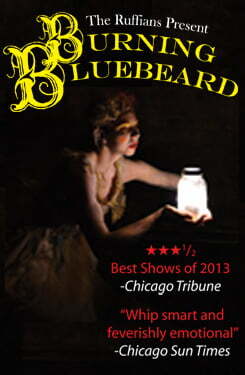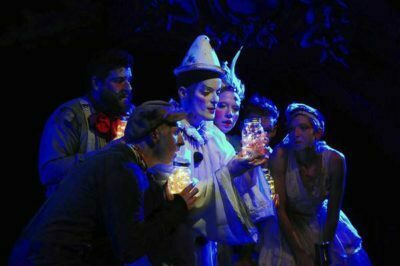Burning Bluebeard
Directed by Halena Kays
Produced by The Ruffians
A Fitting Tribute to Theatrical Tragedy
How does theatre tastefully memorialize its losses? That question haunted author Jay Torrence when he was writing Burning Bluebeard, which is about the December 30, 1903 fire at the Iroquois Theatre on Randolph Street in Chicago in which over 600 people died. It’s an amazing story, but The Ruffians and The Neo-Futurists are clown troupes. However, since the fire occurred during a performance of a pantomime, a humorous fairy tale for children, it’s a better fit than it first appears. Burning Bluebeard is now in its third annual run, and it’s a sad, frightening, and yet often delightful piece.
Upon entering the theatre, audiences are confronted by Dan Broberg and Joe Schermoly’s set design: a burnt out theatre. Of course, nothing would make Theatre Wit look like the Iroquois, which is now the Oriental, but the scenic designers have imaginatively remodeled the playing space to look like it was made of wood, and still latticed with faulty wiring. Also opening the show is sound designer Mike Tutaj’s selection of a particularly sad choral and piano adaptation of Smells Like Teen Spirit, and several body bags littering the stage floor.
Playwright Jay Torrence emerges as Robert Murray, the stage manager from the 1903 production of Mr. Bluebeard. He’s really dreadfully sorry for what happened. Mr. Bluebeard was only supposed to be a fun Christmas story for children, albeit one centered on a racist depiction of a serial killer. It had over four hundred performers, frequently broke up its plot with dumb shows, and featured a beautiful moonlight effect that, unfortunately, caused the fire. Only now, with a live audience in place of the when that died, the company has a chance to make up for what went wrong. The rest of the clowns emerge singed from their body bags, grateful for a chance to redeem themselves, but wracked with guilt, and fearful of a repeat.
While they run down the clock until the fatal scene arrives, the company re-enacts the show and tells us about their hopes for it. Joining them is the mute Faerie Queen (the lanky contortionist Molly Plunk), to create magic effects and safeguard their dreams. Anthony Courser plays Henry Gilfoil, who played Bluebeard, as a cheery goofball who thinks Bluebeard is just misunderstood. The spunky Leah Urzendowski plays Nellie Reed, an aerialist who was one of the few performers who died, with boundless energy. Ryan Walters is Eddie Foy, a tragic vaudeville comedian who, trusting that the fire curtain was actually fireproof, tried to prevent a stampede by telling the children in the audience to remain seated. The new addition this year is Pam Chermansky, as Fancy Clown, an unsettling white-face clown who doesn’t entirely regret that one of her shows impacted the audience in a way the shallow script they intended to put on never could, and allowed them to put on this weightier sequel.
The scenes vary widely in content and tone, but are all skillfully done. One dumb show depicts Bluebeard dispatching his wives to techno music, another, in reference to one of the many unrelated to Mr. Bluebeard’s original plot, is a pastoral comedy. The show includes frequent audience interaction, although nobody is forced to do anything with too much potential for humiliation. Each performer is endearing, even though Chermansky’s part is to keep the gentler rest of the cast moving toward their story’s horrifying conclusion. Director Halena Kays deftly keeps the show on track through emotional swings, and orchestrated with Tutaj and assistant sound designer Mikey Moran a hair-raising climax. Costume designer Lizzie Bracken captured an ambiguity between comedy and tragedy, and lighting designer Maggie Fullilove-Nugent helps the Faerie Queen bring magic to this show with a constellation of hanging bulbs.
At one point the actors, in their characters as actors, pray that the illusion will hold, and they will be seen only as their false identities. At another they awkwardly recount how critics panned Mr. Bluebeard, but the December 30 matinee sold out anyway. It’s the sort of double-layered meaning Torrence’s script delights in, but there’s no need for them to fear. Burning Bluebeard is tasteful, convincing, and a fitting homage to what attracts audiences to theatre. It’s a reminder that the performers you see from the artistically risky pieces like this one to those playing in the for-profit shows Broadway in Chicago hosts at the Oriental today have pure intentions: to tell a story that will make you glad or open your heart. Burning Bluebeard does both.
Highly Recommended
Jacob Davis
Playing at Theater Wit, 1229 West Belmont, Chicago. For tickets, call 773-975-8150. Runs through January 4, 2015; Thursdays, Fridays, and Saturdays at 8:00 pm, Sundays at 3:00 and 7:00 pm, with additional performances on December 27 and January 3 at 3:00 pm, December 29 at 8:00 pm, December 30 at 3:00 and 8:00 pm, and December 31 at 7:00 pm. No performance on December 25, January 1, or on January 4 at 7:00 pm. Tickets are $36-50. Running time is one hundred minutes with no intermission. Show includes water-based haze and flashing lights.




